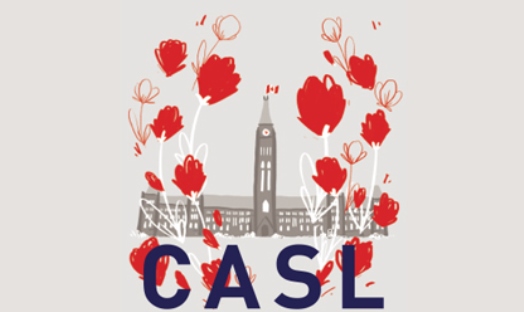The updated Canada’s Anti-Spam Legislation (CASL) comes into effect July 1. If your business sends out email, it will likely have an impact.
This slideshow provides some answers to the most frequently asked questions about CASL and gives you some guidance on how the latest changes apply to your email marketing strategy as well as useful info on exceptions and exemptions.
Learn more about CASL – View our Canadian Anti-SPAM Legislation Workshop Webcast

Image courtesy of Shutterstock
The law states that “a commercial electronic message is an electronic message that, having regard to the content of the message, the hyperlinks in the message to content on a website or other database, or the contact information contained in the message, it would be reasonable to conclude has as its purpose, or one of its purposes, to encourage participation in a commercial activity.”
That covers a lot, says Michael Geist, Canadian research chair in Internet and e-commerce law at the University of Ottawa. “…so long as the content, links, or contact information appears to have as a purpose encouraging commercial activity, it is caught by the definition.”
 Image courtesy of Shutterstock
Image courtesy of Shutterstock
1) The law prohibits sending electronic messages (or causing or permitting messages to be sent) unless the recipient has consented to receive it;
2) Electronic messages must follow a form requirement for specifying identify of the sender, provide contact information of sender and contain an unsubscribe mechanism;
3) The contact information of the sender must remain valid for at least 60 days after the message was sent.

General exceptions that exclude messages from all requirements include:
• Messages between individuals with a personal or family relationship. The regulations indicate these messages involve direct, voluntary, two-way communications
• Messages sent between employees within an organization
• Messages sent to a business (or person engaged in a commercial activity) where the message consists of an inquiry or application related to that commercial activity
• Messages sent in response to a request, inquiry or complaint
• Messages sent on an electronic messaging service (such as a social media direct message service) provided that there is adequate information and unsubscribe mechanisms on the service site
• Messages sent to a limited-access secure and confidential account to which messages can only be sent by the person who gave the account to the recipient
• Messages sent to satisfy or enforce a legal or juridical obligation
• Messages sent to recipients outside the country with qualifying anti-spam laws (see jurisdiction discussion below)
• Two-way voice calls, faxes, and voice recordings sent to a telephone account
 Image courtesy of Shutterstock
Image courtesy of Shutterstock
• Quotes or estimates sent to someone who has requested it
• completion of commercial transactions
• Providing warranty, product recall or safety information
• Notifying the recipient of factual information about an ongoing product, service, subscription, membership, account, etc.
• Information directly related to an employment relationship
• Delivering a product, good or service (including product upgrades) if the recipient was entitled to receive it
• One third-party referral message, subject to certain requirements (including naming who made the referral in the message)
 Image courtesy of Shutterstock
Image courtesy of Shutterstock
Are telecom providers, charitable organizations, political organizations and educational institutions exempt from CASL?
There is no exception specifically for education institutions. However, there are some “non-business relationship” clauses that may apply in some cases, according to data management, software and service provider Whatcounts.com
Registered charities are exempt provided that the primary purpose of the message is to raise money for the charity. Political parties and political candidates are exempt if the primary purpose of the of the message is to ask for contribution.
Telecom providers are exempt when their role in the communication of the message is limited to providing telecommunication service.

The law generally requires express consent. This type of consent requires identifying the purpose for why consent is being requested and must identify who is seeking consent. This consent may not involve pre-checked boxes, rather there must be an express, opt-in by the user. Express consent can be obtained verbally, but it will be harder to prove verbal consent if there are any challenges.
There are some instances were implied consent in allowed:
•When there is an existing business relationship between sender and recipient. This could include any purchase of a product, good or service within the prior two years, acceptance of a business opportunity within the prior two years, a written contract between the two parties from the previous two years, or any inquiry within the prior six months
•There is an existing non-business relationship between sender and recipient. Includes donations or volunteer work to or for charities, political parties, and political candidates, as well as membership over the prior two years in a club, association, or voluntary organization
•Recipients email address has was prominently published, there is no statement indicating the recipient does not want to receive messages and the messaged is related to the recipient’s business, role or duties
•The recipients email was disclosed to the sender, there’s no statement that the recipient does not want to receive messages and the message is related to the person’s business, role or duties

CASL establishes some specific requirements when requesting express consent for the purposes of sending a commercial electronic message (CEM), says Shaun Brown, a CASL expert and lawyer at nNovations LLP.
“It seems unlikely that a ‘like’ or ‘follow’ could be characterized as meeting these specific requirements,” said Brown in a recent interview with Constantcontact.com.

“It is arguable” that the recipient is providing electronic address directly to the sender by this method, according to Brown.
He said the sender could take action to make sure people are well aware of his or her intentions.
For instance, the sender could post a sign by the fishbowl stating that by dropping their cards in, people are consenting to receive commercial electronic messages.
The burden lies on the sender of the message to prove that consent was obtained according to the requirements of the law, said Brown.

CASL applies to messages sent to Canadians and is invoked when a computer system in Canada is used to send or access the message, said Geist.
There are exceptions involving Canadian organizations that send messages outside Canada. Sending messages to people in a country with its own anti-spam law means those local laws will apply.
Routing a message through Canada, but not using Canadian computer servers to send or access messages, does not trigger CASL.
For transaction emails, will replying to the email count as an unsubscribe method?
CASL mandates the unsubscribe link be valid and working, and be specifically called out within the email, according to Whatcounts.com.
Either an email address or a link to an unsubscribe form should be included, with wording instructing the user how to unsubscribe.
Senders must assume that the recipient wants to unsubscribe from all mailings.
[relevant url="http://www.cbc.ca" text="Related Link :"]Find out more about CBC[/relevant]
Learn more about CASL – View our Canadian Anti-SPAM Legislation Workshop Webcast

Image courtesy of Shutterstock